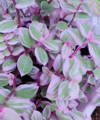Tradescantia Pink Panther is a tropical houseplant known for it's small, but bright pink variegated leaves. The tiny leaves puff out and once growing, although delicate, you'll see new leaves shoot off consistently. This plant grows pretty quickly and vigorously once it starts shooting roots. Besides a more frequent watering schedule, this plant is very easy to care for. One thing to be aware of is that Tradescantia typically need a lot of sunlight to stay looking and feeling its best.
Native to South America and the Carribean
Commelinaceae
Pink Lady, Pink Panther Callisia, Callisia repens Rosato, Pink Turle, Tango Callissia, Callissia Bianca, Callissia Tango and Callissia Tri-Color.
Tradescantia are one of the most colorful plant families out there! Some other common types are Tradescantia fluminensis, Tradescantia blossfeldiana, Tradescantia sillamontana, Tradescantia spathacea, Tradescantia virginiana, Tradescantia longipes, Tradescantia mollipila, Tradescantia pallida (“Purple Heart”), and Tradescantia Callisia.
Can be mildly toxic to pets and humans if consumed.

For healthy plants, we recommend that you add water to the glass every 1 -2 weeks (or if you see that water levels have lowered) to replenish the water that evaporated or absorbed from the plants. Then, replace the water every 2-4 weeks.
Most tap water works great but distilled or filtered waters are recommended if available.
Tradescantia prefers bright, indirect light but grows well in partial direct light as well. In lower light settings, expect your tradescantia to be a bit more leggy as the plant stretches for brighter light.
On the other hand, Tradescantia one of the few that thrive in direct sunlight! The more sun it gets, the more the color starts to pop
Ideal temperatures are between 65 and 85 degrees but this plant will continue to grow in somewhat warmer temperatures as well.
One key rule for most tropical houseplants like the Tradescantia flumensis variegata is: if you're comfortable, then your plants are comfortable too!
Tradescantia has no special humidity requirements. They typically like to be relatively moist (but not soggy), so feel free to mist your plant frequently during dryer seasons.
Tradescantia tend to be an easy plant to propagate in water. Simply submerge a node in water with at least 3 leaves above it, and then place it in a warm space with good indirect sunlight. Nodes can easily be identified by finding any point at which a leaf is growing. Simply remove the leaves and your node is ready to grow roots.
See the video above for a full step by step walkthrough!
Identification: A lack of colored stripes on the leaves and/or dulling of color
Cause: Not enough Light
How to treat:Try experimenting with different places around your home. Generally, areas closer to windows is a good start but also testing other walls and spaces helps.
Identification: Deep purples begin to fade in new leaf growth
Cause: Insufficient nutrients
How to treat:Track down a liquid nutrient solution that you can add to your water and begin adding drops once or twice a month.
Identification: Dead or browning leaves
Cause:If the leaves are older (closer to the roots), this may be natural and part of the natural plant growth. Newer leaves growing in brown is likely a lack of oxygen in the water. Additionally, leaves which end up submerged in water will turn brown.
How to treat:For all of the scenarios above, removing the dying leaves is the first step. Then, if the issue is a lack of oxygen in the water, simply replace the water for the plant and then continue on a 2 week to monthly water replacement schedule.